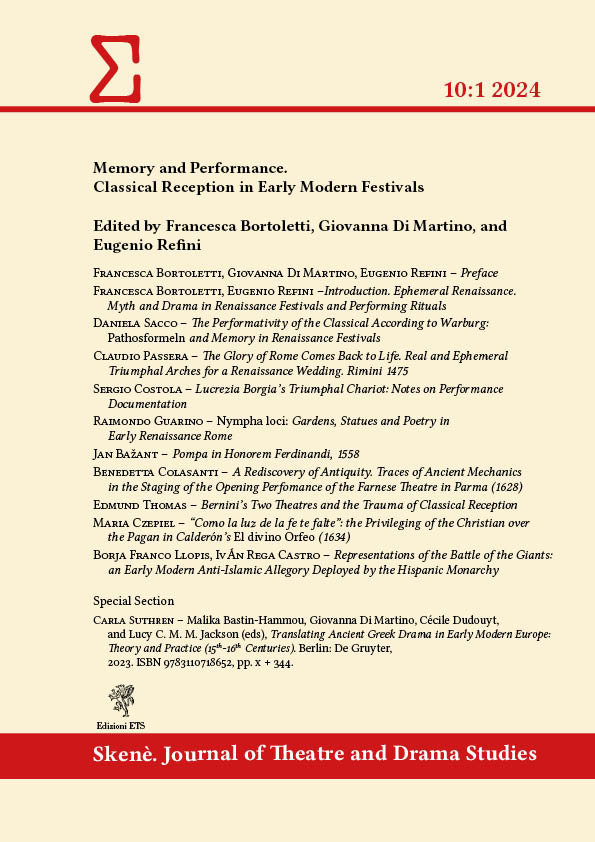Lucrezia Borgia’s Triumphal Chariot: Notes on Performance Documentation
DOI:
https://doi.org/10.13136/hc7bsv76Abstract
This paper explores Lucrezia Borgia’s engagement with ancient forms at the Este court, focusing on her utilisation of the triumph. It argues that conventional labels such as ‘actress’ or ‘playwright’ fail to encapsulate the rich and varied theatrical contributions of women in this era, who, during this period, constantly overstepped the bounds of traditional theatre moving into broader fields of cultural and theatrical activity. Together with traditional categories of theatre production, then, it’s important to also consider modes of performance, on one hand, located in the domestic and personal spheres and, on the other, to the ways in which they were connected to both the circulation and use of objects. By examining entries from account books detailing expenses for a ‘carro triunfante de la Duchessa’ in December 1507 and October 1508, the paper investigates how Lucrezia Borgia employed the triumph as a strategic means to navigate and construct her social identity. It focuses on two specific events: the celebrations organized for the wedding of Camillo Costabili and Bianca Martinengo in 1507, and the triumph over the river Po, organized to celebrate Ferrara’s victory over Venice at the battle of Polesella in 1509. This approach not only offers fresh insights into historical performance but also prompts a reassessment of the role of archival documents in shaping and preserving meaning.
Keywords: Lucrezia Borgia, triumphal chariots, Este court, Performance documentation, Celio Calcagnini
Downloads
Published
Issue
Section
License
Copyright (c) 2024 Skenè. Journal of Theatre and Drama Studies

This work is licensed under a Creative Commons Attribution 4.0 International License.
Open Access Policy
This journal provides immediate open access to its content on the principle that making research freely available to the public supports a greater global exchange of knowledge.
This Journal is a CC-BY 4.0 publication (https://creativecommons.org/licenses/by/4.0/). This Licence allows others to share the work with an acknowledgement of the work’s authorship and initial publication in this Journal, providing a link to the Licence and explicitly underlining any change (full mention of Issue number, year, pages and DOI is required).
- The Author retains (i) the rights to reproduce, to distribute, to publicly perform, and to publicly display the Article in any medium for any purpose; (ii) the right to prepare derivative works from the Article; and (iii) the right to authorise others to make any use of the Article so long as the Author receives credit as Author and the Journal in which the Article has been published are cited as the source of first publication of the Article. For example, the Author may make and distribute copies in the course of teaching and research and may post the Article on personal or institutional Web sites and in other open-access digital repositories.
- The Author is free to enter into separate, additional contractual arrangements for the non-exclusive distribution of the Journal’s published version of the work, with an acknowledgement of its initial publication in this Journal and explicitly underlining any change (full mention of Issue number, year, pages and DOI is required).
- The Author is permitted and encouraged to post their work online after the evaluation process has been successfully passed, as it can lead to productive exchanges as well as to a wider dissemination of the published work.

